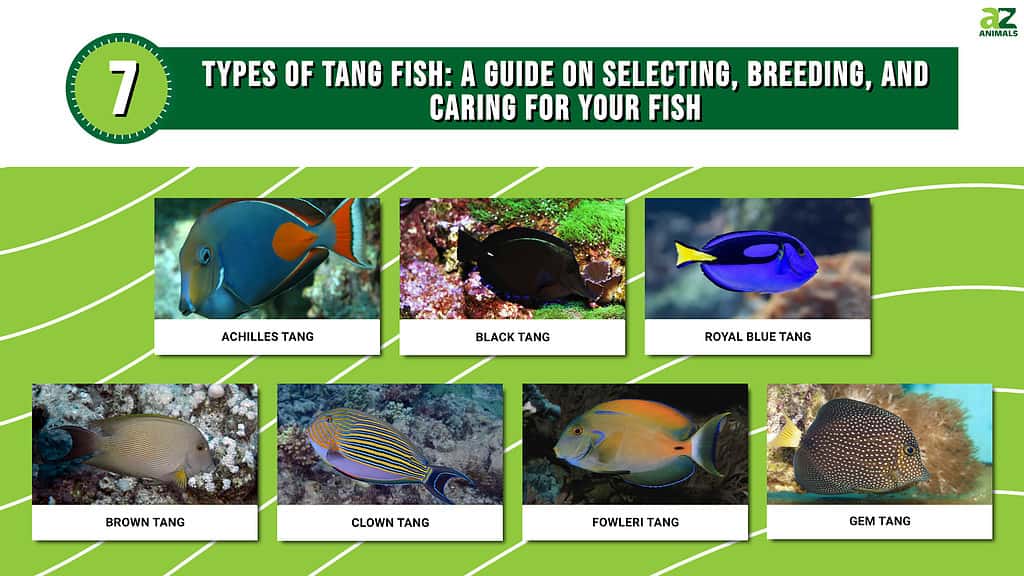
Tang fish, also known as surgeonfish, is a popular choice for aquarium enthusiasts due to their vibrant colors and unique body shape. They belong to the Acanthuridae family of marine fish and can be found in tropical waters around the world.
One reason why people like to keep tang fish in aquariums is that they can add a beautiful touch of color and movement to any tank. Tangs come in many different varieties, each with its own distinct coloring patterns and personalities.
Another reason why tangs are so popular is that they have interesting feeding behavior. They graze on algae throughout the day, which means that they require a diet rich in plant matter. This makes them ideal for aquarists who want to maintain a healthy ecosystem within their tanks.
However, it’s important to remember that caring for tang fish requires some knowledge and attention. These creatures need plenty of space to swim around in, as well as clean water conditions with proper filtration systems. It’s also essential to choose compatible tank mates when setting up an aquarium with tangs.
Overall, if you’re looking for a unique and colorful addition to your home aquarium setup or simply want more information about selecting, breeding, or caring for your favorite type of tang fish, then this guide may help you learn everything you need!
7 Types of Tang Fish
Tangs come in a variety of colors and sizes, which is why they are favored for saltwater aquariums. They can be expensive purchases, so it’s best to save up your money before bringing one home. Furthermore, selecting captive-bred tang fish can be more cost-effective. It’s important to ensure that the tank is properly set up for the fish when it arrives.
1. Achilles Tang (Acanthurus achilles)
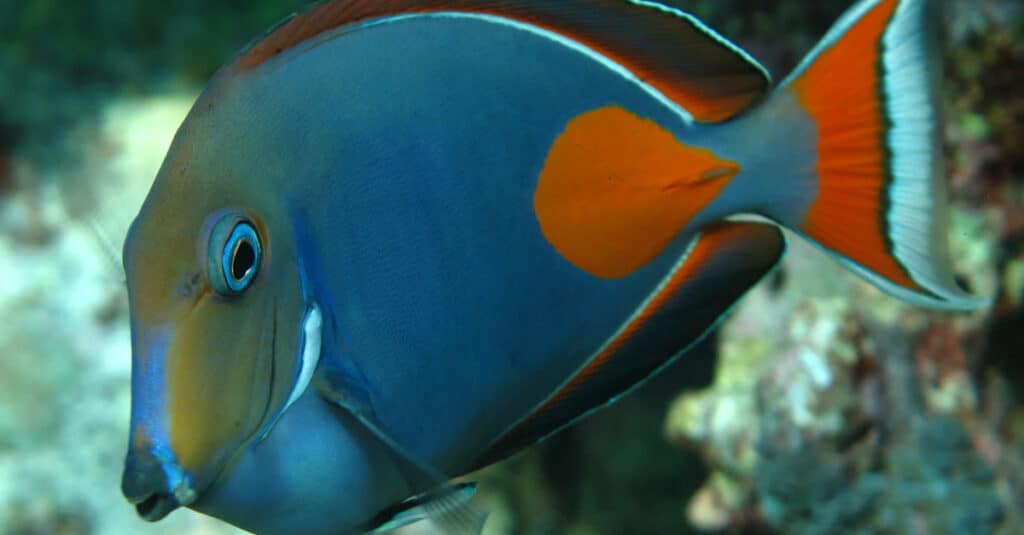
The Achilles tang boasts a bright white spine on its tail which gives it a unique look among other tangs.
©Karl Keller/Shutterstock.com
The Achilles tang, scientifically known as Acanthurus achilles, is a popular species of tang fish that is famous for its striking appearance and vibrant colors. This fish belongs to the family Acanthuridae and is commonly found in the waters of Hawaii and other Pacific regions. The Achilles’ tang has a distinctive body shape with a pointed snout, a sharp dorsal fin, and an elongated caudal fin.
The coloration of this fish varies from deep blue to black on its upper body, while the lower half showcases an orange-yellow hue. The Achilles tang also boasts a bright white spine on its tail which gives it a unique look among other tangs. Due to their attractive features, many home aquarium enthusiasts prefer keeping them as pets.
However, caring for these beautiful creatures can be quite challenging as they require specific conditions to thrive in captivity. They need plenty of space to swim around freely, along with suitable lighting and water quality parameters such as pH level, temperature, salinity levels, etc., all of which must be closely monitored by their owners.
Moreover, breeding this species is not easy either since they are difficult to sex due to their similar physical characteristics between male and female specimens. Despite the challenges associated with owning an Achilles tang (Acanthurus achilles), taking care of them can be very rewarding if done correctly – allowing you to enjoy one of nature’s most stunning marine creatures right in your own home!
2. Black Tang (Zebrasoma rostratum)
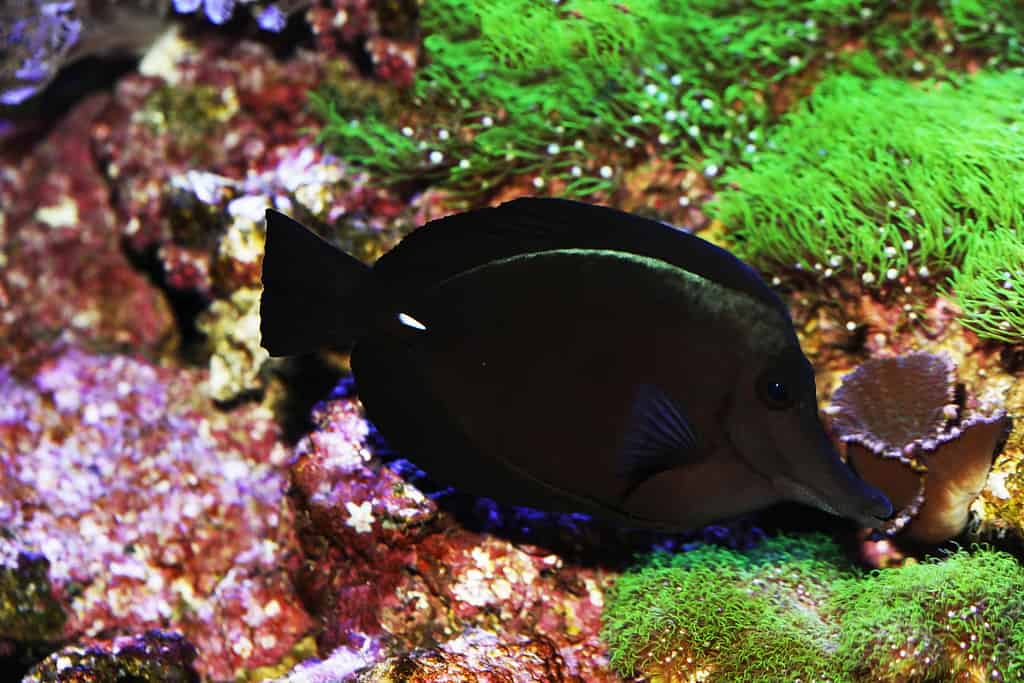
The black tang fish is also known as a black longnose tang because of its long snout.
©Pavaphon Supanantananont/Shutterstock.com
The black tang, scientifically known as Zebrasoma rostratum, is a beautiful and striking fish that belongs to the family Acanthuridae. It is also commonly referred to as the black longnose tang due to its elongated snout. This species of tang is native to the waters surrounding Hawaii and can be found living in coral reefs at depths ranging from 10-80 meters.
The black tang has an impressive appearance, with a dark black body. Some black tangs are covered in white spots scattered across its dorsal fin, anal fin, and tail. Its fins are outlined in bright yellow, which accentuates its elegant features further. The combination of these colors gives it a distinct look that makes it one of the most sought-after fishes for home aquariums.
When selecting this type of tang for your aquarium, it’s important to consider their size since they can grow up to 10 inches long. You’ll need an adequate-sized tank with plenty of swimming room and hiding places where they can retreat when needed. They’re generally peaceful fish but may become aggressive towards other tangs or similar-looking species if kept together.
Caring for your black tang involves providing them with nutritious food options such as algae sheets or pellets while ensuring that water quality remains stable within acceptable parameters through regular water changes using high-quality filtration systems.
3. Royal Blue Tang (Paracanthurus hepatus)
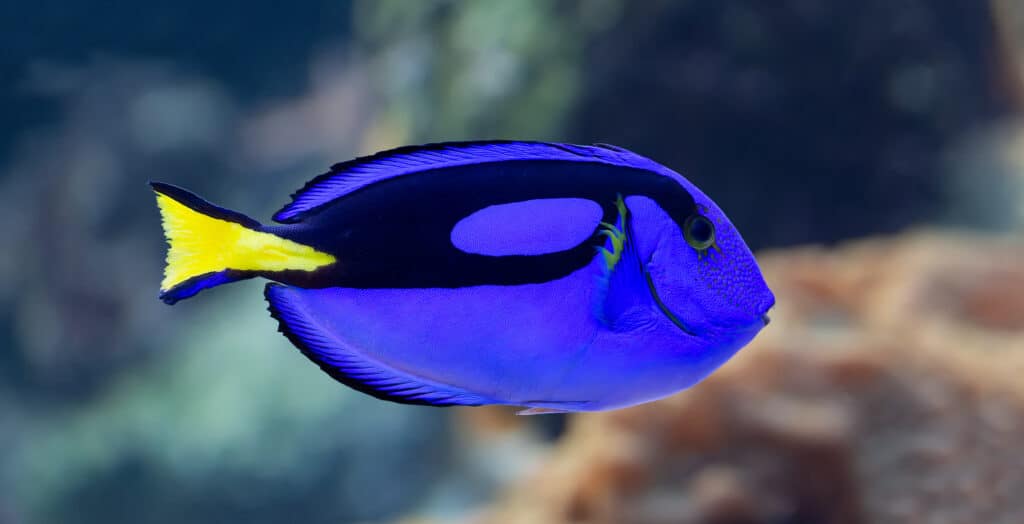
The royal blue tang, also known as the palette surgeonfish, has a vibrant blue body with bold black markings.
©Henner Damke/Shutterstock.com
The royal blue tang, also known as the palette surgeonfish, is a popular and striking addition to any aquarium. This tropical fish has a vibrant blue body with bold black markings that add depth and contrast.
When selecting a royal blue tang for your tank, it’s important to choose one that is healthy and disease-free. Look for clear eyes, smooth skin without any signs of discoloration or spots, and active swimming behavior.
In terms of breeding this species in captivity, it can be challenging due to their specific water requirements and dietary needs. It’s recommended only to attempt breeding if you have experience with other, more manageable species first.
Caring for a royal blue tang involves providing them with plenty of swimming space (at least 180 gallons per fish) along with live rock structures on which they can graze throughout the day. They require consistent water quality parameters such as pH levels between 8.1-8.4 and temperature around 78 degrees Fahrenheit.
Feeding these fish requires offering both vegetable matter, such as algae sheets, alongside high-quality pellets or fresh foods like lettuce or spinach.
Overall, the royal blue tang is an impressive species that will bring life and color into your aquarium if cared for properly.
4. Brown Tang (Acanthurus nigrofuscus)
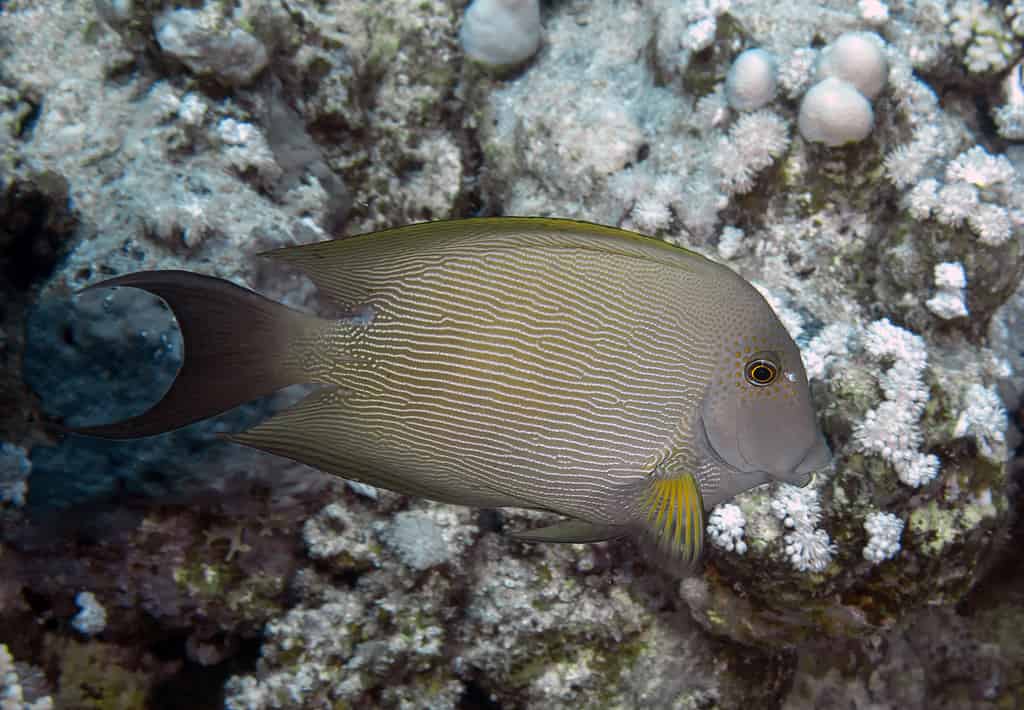
Brown tang can grow up to 8.5 inches in length.
©iStock.com/Rob Atherton
The brown tang, also known as the brown surgeonfish, is a popular fish among aquarium enthusiasts due to its striking appearance and ease of care. This species belongs to the Acanthuridae family and is native to the Pacific Ocean.
The body of this tang fish is highly recognizable due to its chocolate brown coloration that covers most of its body. Additionally, some have a bright yellow dorsal fin, and the tail fin contrasts beautifully against its brown base color.
A consideration when adding a brown tang into your aquarium is their size. These fish can grow up to 8.5 inches in length, which means they require ample swimming space in order to live comfortably. Therefore, it’s recommended that you have at least a 75-gallon tank if you want these beautiful creatures as pets.
When caring for your brown tangs, make sure that they are fed with high-quality food, such as algae flakes or pellets designed specifically for herbivorous marine fish. Also, ensure there is plenty of hiding spots within your aquarium so that these shy fishes feel safe.
Breeding brown tangs can be quite challenging since they prefer shallow reef environments where breeding occurs naturally under specific environmental conditions. However, some hobbyists have had success by providing them with ideal spawning conditions inside their tanks.
5. Clown Tang (Acanthurus lineatus)
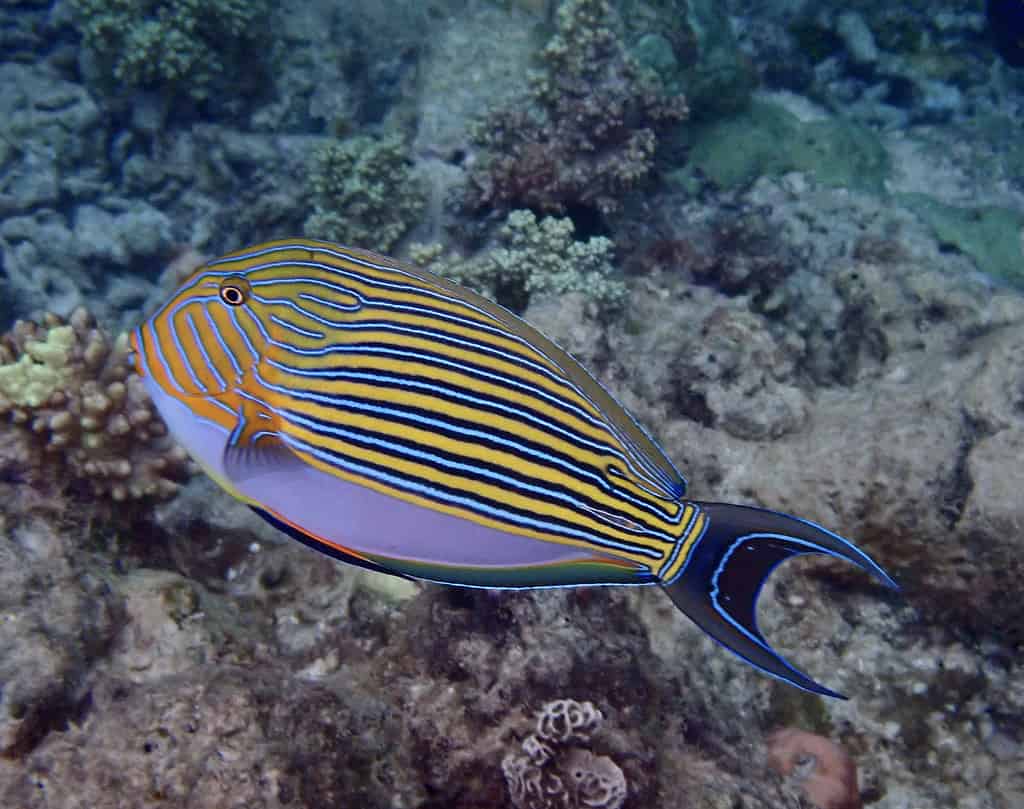
The clown tang has elongated fins and bold vertical yellow, black, and blue stripes.
©iStock.com/Katherine OBrien
The clown tang, scientifically known as Acanthurus lineatus, is a popular tropical fish that belongs to the family of surgeonfish. With its striking appearance and vibrant colors, this species has become a favorite among hobbyists who are looking for an eye-catching addition to their aquarium.
The clown tang boasts a unique body shape with elongated fins that add to its overall appeal. Its body is predominantly yellow with black stripes that run vertically along its sides which are lined in blue. The dorsal fin of the clown tang is also accented by bright blue markings making it even more visually impressive.
While these fish may be aesthetically pleasing, they do require specific care needs in order to thrive in captivity. They prefer tanks with plenty of swimming space (180 gallons) and hiding spots where they can retreat when needed. These fish have spines on their tails which can cause injury if mishandled or agitated, so caution should always be taken.
When it comes to feeding, the clown tang requires a diet consisting primarily of plant-based foods such as algae and seaweed but will also consume small amounts of meaty foods like brine shrimp or krill.
Breeding the clown tang can prove difficult due to their natural inclination towards migrating long distances during the spawning season; however, successful breeding efforts have been documented in larger aquariums with proper conditions provided.
6. Fowleri Tang (Acanthurus fowleri)
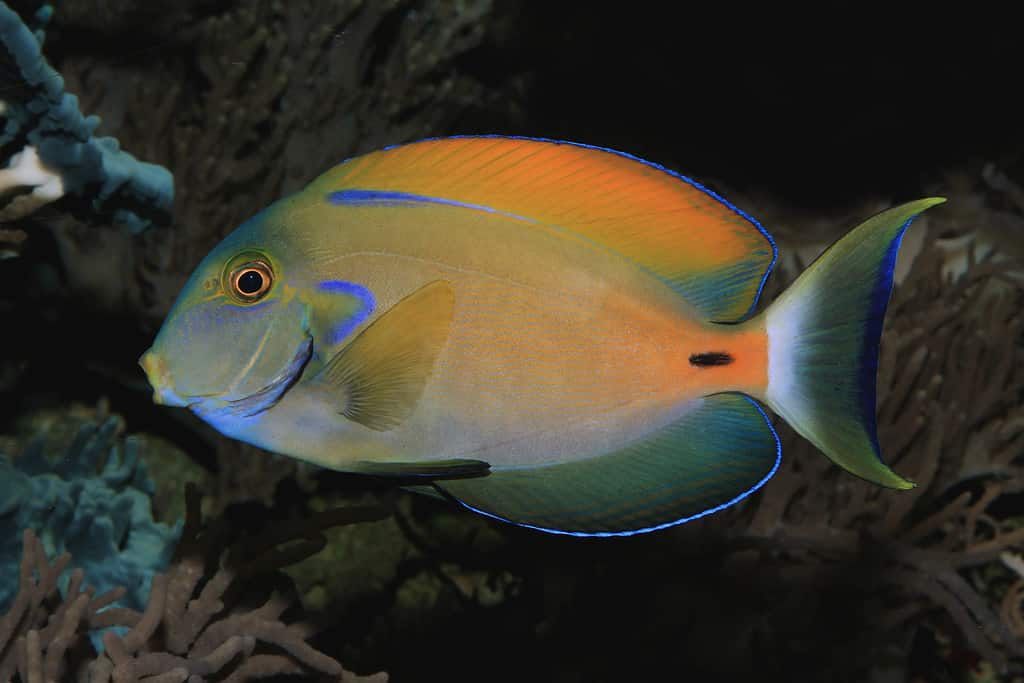
can grow up to 18 inches in length requiring a 300-gallon tank to thrive.
©Michal Sloviak/Shutterstock.com
The Fowleri tang, scientifically known as Acanthurus fowleri, is a strikingly beautiful saltwater fish that belongs to the family Acanthuridae. Native to the waters of Indonesia, this species features an eye-catching coloration consisting of vibrant shades of blue and yellow.
These tangs are generally peaceful in nature but can become aggressive towards other tangs or similar-looking fish if they feel threatened or overcrowded in their aquarium. It’s best to provide them with ample swimming space and plenty of hiding spots within their tank. They also require clean water conditions with proper filtration systems.
Fowleri tangs thrive on a diet rich in vegetables such as seaweed, lettuce, spinach, and algae. Additionally, it’s essential to maintain stable water parameters for optimal health and growth.
If you’re considering adding a Fowleri tang to your collection, make sure you have adequate space. They get up to 18 inches long and require a 300-gallon tank to thrive. With proper care and attention given to their needs, Fowleri tangs can be a delightful addition to any aquarium setup!
7. Gem Tang (Zebrasoma gemmatum)
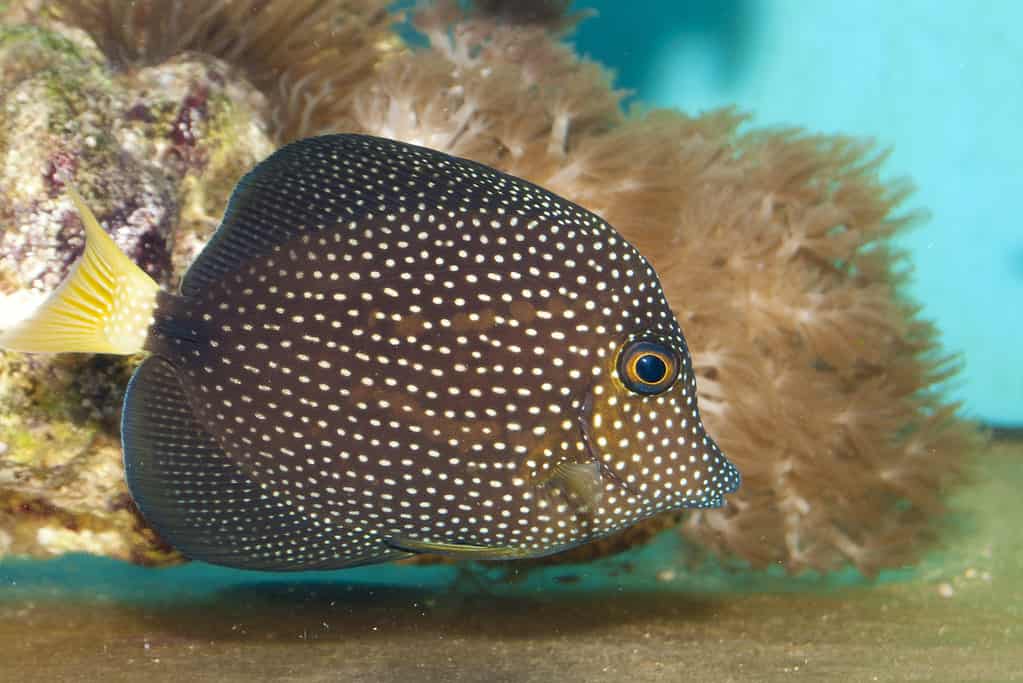
Gem tang has a dark blue body with distinctive yellow spots resembling gems.
©iliuta goean/Shutterstock.com
The gem tang, also known as Zebrasoma gemmatum, is a beautiful and unique species of tang fish that can make an excellent addition to any aquarium. These fish are native to the waters surrounding Madagascar and other nearby islands in the Indian Ocean. They have distinctive coloring with a dark blue body and bright yellow spots that resemble precious gems.
In terms of size, gem tangs can grow up to 8.5 inches long when fully matured. They require a large tank (120 gallons) with plenty of swimming space and hiding places such as rocks or coral structures. Due to their territorial nature, it’s recommended to keep only one gem tang per tank unless you have a very large setup.
When it comes to diet, these fish are herbivorous and thrive on a varied diet consisting mainly of algae-based foods such as spirulina flakes or pellets. It’s important not to overfeed them since they’re prone to digestive issues if fed too much.
Breeding gem tangs in captivity are quite challenging due to their specific mating habits, which involve spawning at dawn during certain times of the year. However, successful breeding has been achieved by some experienced aquarists who have created optimal conditions in their tanks for this purpose.
Overall, caring for gem tangs requires some effort but can be highly rewarding for those willing to put in the work. Their stunning appearance, combined with their interesting behavior, makes them a fascinating addition to any reef aquarium community.
Behavior
Tang fish are generally known for being aggressive and not tolerating other tangs in their space, even other members of their own species. Despite this, there are cases of tang fish traveling together in the wild with no issues. However, when placed in a marine tank, they tend to start fighting with their scalpel-like teeth.
If a fish loses in a dispute, it will typically flee to a secure spot. Unfortunately, this stress and the lack of food can prove to be fatal. Tangs are also very aggressive when encountering fish from other types, even if they look similar. Pitting a tang against an angelfish or a butterflyfish is dangerous since these species don’t have spines for protection.
The most effective way to avoid aggressive behavior from tang fish is just to have one in your tank. Creating a reef environment in order to separate them may work, but it could be a risky move since they are not the hardiest of fish. To be safe, it is best to just stick with one individual.
Lifespan

In the wild, some species of tang can live as long as 30 years.
©iStock.com/pclark2
In the wild, some species of tang can live as long as 30 years. With excellent care, it is possible that your fish can thrive for up to 25 years. However, the average lifespan of a tang in captivity is much shorter, some often only lasting a few weeks. It is important to maintain a well-cycled saltwater aquarium with ideal water conditions since any fluctuation in ammonia, nitrates, or nitrites can cause a great deal of stress and may lead to death.
If you want to know if there is an illness in your aquarium, watch for signs in your tang fish. Marine ich is particularly dangerous for these fish, so it is important to quarantine them for two weeks before introducing them to the tank. This will help protect your other fish from any illnesses they may have been exposed to during transport.
You should think about keeping tangs and cleaner shrimp together since they can help each other out. It is like a natural partnership, so you should look at the area where your tangs come from and find the shrimp that live in the same place. This way, you can watch the cleaning process happen naturally.
Diet
Tangs are herbivores, which means they spend their days grazing on the reef for microalgae. This makes them an excellent addition to any tank, as they help clean the water. However, it can be difficult to make sure they are getting enough food, especially if there are other algae-eaters living in the tank. Supplementing their diet with spirulina-based commercial food is an easy way to ensure they get enough nutrition.
You can also add real plants to the fish’s diet. Nori sheets are a great choice and can be easily clipped onto the tank. To make sure the tang fish gets all the necessary proteins and vitamins, provide occasional sources of protein, such as mysis and brine shrimp. Even though this is not a typical food for a herbivore, it is effective and beneficial to these fish. The vegetables in their diet may lack certain proteins and vitamins, which can be remedied by the shrimp.
Nutritional deficiencies can cause head and lateral line erosion in tangs, which is a scary-looking disease but is easily corrected with the right diet. When quarantining your tang, observe their feeding habits to make sure they are getting enough food and what they prefer to eat.
Summary of 7 Types of Tang Fish
| Tang | Origin | Size | Difficulty Level | Aggression Level | Minimum Tank Size | Price |
|---|---|---|---|---|---|---|
| Achilles Tang | Pacific | 10 inches | Difficult | Aggressive | 120 gallons | $600 |
| Black Tang | South Pacific | 10 inches | Easy | Aggressive | 120 gallons | $1,400 |
| Royal Blue Tang | Indo-Pacific | 12 inches | Moderate | Semi-Aggressive | 180 gallons | $250 |
| Brown Tang | South Pacific | 8.5 inches | Easy | Semi-Aggressive | 75 gallons | $40 |
| Clown Tang | Indo-Pacific | 14 inches | Moderate | Aggressive | 180 gallons | $60 |
| Fowleri Tang | Indonesia | 18 inches | Moderate | Peaceful | 300 gallons | $250 |
| Gem Tang | Indian Ocean | 8.5 inches | Moderate | Semi-Aggressive | 120 gallons | $2,000 |
The photo featured at the top of this post is © Tatiana Belova/Shutterstock.com
Thank you for reading! Have some feedback for us? Contact the AZ Animals editorial team.






